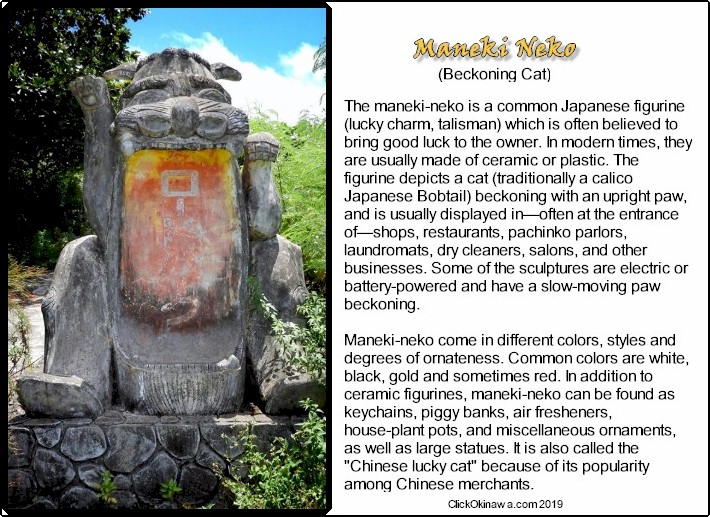
|
|
MANEKI NEKO
"Beckoning Cat"
Published November 5, 2019
|

photo source: Rob Oechsle
|
Composition
Antique examples of maneki-neko may be made of carved wood, stone and metal, handmade porcelain or cast iron. History It is commonly believed that Maneki-neko originated in Tokyo (then named Edo), while some insist it was Kyoto. Maneki-neko first appeared during the later part of the Edo period in Japan. The earliest records of Maneki-neko appear in the Bukô nenpyô's (a chronology of Edo) entry dated 1852. Utagawa Hiroshige's ukiyo-e "Joruri-machi Hanka no zu," painted also in 1852, depicts the Marushime-neko, a variation of Maneki-neko, being sold at Senso temple, Tokyo. In 1876, during the Meiji era, it was mentioned in a newspaper article, and there is evidence that kimono-clad maneki-neko were distributed at a shrine in Osaka during this time. A 1902 advertisement for maneki-neko indicates that by the turn of the century they were popular. Beyond this the exact origins of maneki-neko are uncertain. Some have noted the similarities between the maneki-neko's gesture and that of a cat washing its face. There is a Japanese belief that a cat washing its face means a visitor will soon arrive. This belief may in turn be related to an even older Chinese proverb that states that if a cat washes its face, it will rain. Thus, it is possible a belief arose that a figure of a cat washing its face would bring in customers. In his Miscellaneous Morsels from Youyang, China's Tang Dynasty author Duan Chengshi (803?–863) wrote: "If a cat raises its paw over the ears and washes its face, then patrons will come". Statues of cats washing their ears (though very different in style to Maneki-Neko) have been found as early as the Northern Wei Dynasty (386 to 534 AD). There are many legends about the birth of Maneki Neko, of which the most popular is the legend of Gotoku temple. In the 17th century, a poor monk lived in a small temple in Tokyo. Although his life was very difficult, he shared his own meager meals with his pet cat, Tama. One day, Lord Nakaota Ii of the Hikone district was on the way to hunt when suddenly a storm came, and he had to seek safety under a big tree near the temple. Sheltering there, he noticed the cat, Tama, raising one paw as if waving him to the temple. Curious, he left his cover and headed for the temple to have a better look at the strange cat. As he did so, a lightning bolt destroyed the tree he had just stood beneath. Nakaota was so grateful, he became the patron of the temple, repaired it to become more spacious and in 1697 renamed it Gotoku temple. When Tama died, he was buried in a special graveyard for cats. In the temple, a statue of Maneki Neko was made to commemorate this special cat that has been revered ever since. Alternatively, according to a folktale the operator of an impoverished shop (or inn, tavern, temple, etc.) took in a starving stray cat despite barely having enough to feed himself. In gratitude, the cat sat in the front of the store beckoning customers, thus bringing prosperity as a reward to the charitable proprietor. Ever after, the "beckoning cat" has been a symbol of good luck for small business owners. In popular culture Modern Japanese superstition suggests that keeping a talisman of good fortune, such as the maneki-neko, in bedrooms and places of study will bring about favorable results and life successes. Because of its popularity in Chinese communities (including Chinatowns in the United States) the maneki-neko is frequently mistaken for being Chinese in origin rather than Japanese, and is incorrectly referred to as a "Chinese lucky cat" or jinmao ("golden cat"). The Pokemon named Meowth is based upon the maneki-neko. Unlike traditional Maneki-neko who hold the Koban coin, Meowth has the coin projected from its forehead. Meowth can fire this coin as a projectile weapon with its signature move Payday. Netta performed her song "Toy" in front of two walls full of maneki-neko at the Eurovision Song Contest 2018. She won the competition after collecting 529 points at the final. |
©2019 Contact: ClickOkinawa.com

